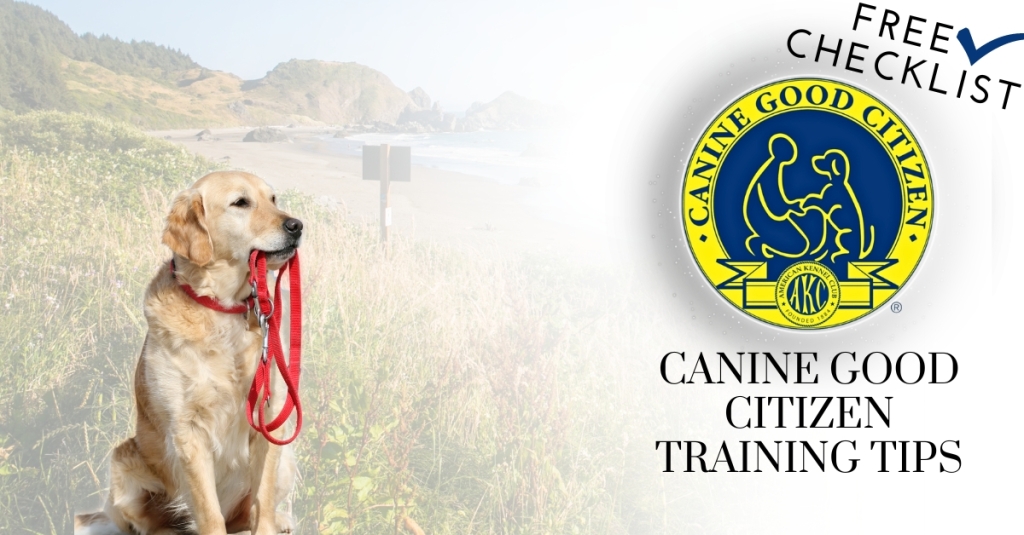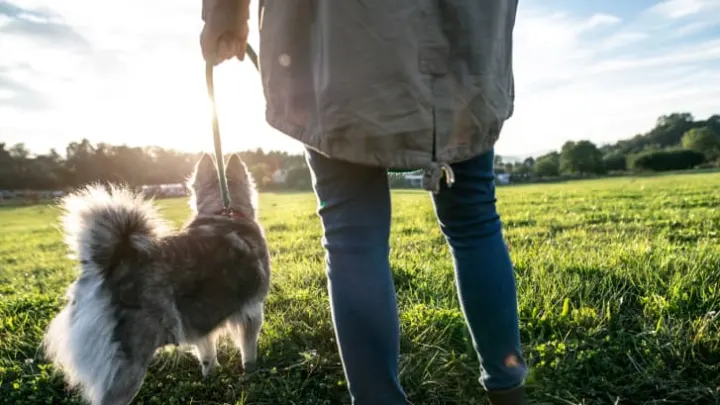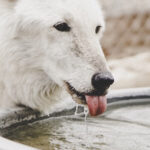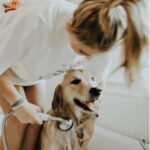To socialize an anxious rescue dog effectively, start with positive reinforcement training and gradual exposure to new experiences. This will help build trust and confidence in your dog.
Introducing an anxious rescue dog to new social situations can be challenging, but with patience and the right approach, it is possible to help your furry friend overcome their anxiety and become more comfortable around people, other animals, and various environments.
Understanding the unique needs of rescue dogs and utilizing positive reinforcement techniques can make a significant difference in their socialization process. We will explore effective ways to socialize an anxious rescue dog, from creating a safe and supportive environment to gradually exposing them to new experiences, all while building trust and confidence in the process. By implementing these strategies, you can help your rescue dog feel more at ease and confident in social situations, ultimately improving their overall well-being and quality of life.

Credit: sharonward97444.wordpress.com
1. Understanding Anxiety In Rescue Dogs
1.1 Signs Of Anxiety In Rescue Dogs
Signs of Anxiety in Rescue Dogs can vary from dog to dog, but common indicators include excessive barking, whining, pacing, drooling, trembling, and destructive behavior. Some rescue dogs may also display signs of aggression, fear of certain stimuli, or withdrawal from social interaction. Recognizing these signs is crucial in addressing the issue effectively.
1.2 Causes Of Anxiety In Rescue Dogs
Causes of Anxiety in Rescue Dogs typically stem from past traumatic experiences, lack of socialization, sudden changes in environment, or long-term confinement in shelters. These experiences can lead to a profound sense of insecurity and fear in rescue dogs, causing them to exhibit anxiety-driven behaviors. Understanding these causes is essential in devising a personalized approach to help the anxious rescue dog adjust to their new environment.
2. Creating A Safe And Supportive Environment
Creating a safe and supportive environment is crucial for socializing an anxious rescue dog. By providing a calm and structured setting, utilizing positive reinforcement techniques, and gradually exposing the dog to new experiences, you can help them overcome their anxieties and develop healthy social skills.
Creating a Safe and Supportive Environment 2.1 Establishing a Routine 2.2 Setting Boundaries 2.3 Providing a Safe Space Rescuing an anxious dog can be both challenging and rewarding. One of the most crucial aspects of helping an anxious rescue dog adapt to their new home is creating a safe and supportive environment. This means establishing a routine, setting boundaries, and providing a safe space for the dog to feel comfortable and secure. These strategies can be effective in helping your anxious rescue dog feel more at ease and gradually transition into their new environment. 2.1 Establishing a Routine Establishing a consistent daily routine can help an anxious rescue dog feel more secure and less anxious. Dogs, especially those that have previously experienced trauma, thrive on routine. This includes regular feeding times, exercise, playtime, and rest. By providing a predictable schedule, you can help your dog feel more comfortable and better able to anticipate what comes next. 2.2 Setting Boundaries Setting clear boundaries is essential for any dog, but particularly for anxious rescue dogs. This involves establishing rules around behavior, such as not jumping on furniture or not begging at the table. Consistency is key when enforcing these boundaries, as it helps the dog feel secure in understanding what is expected of them. 2.3 Providing a Safe Space Creating a safe space within your home where your anxious rescue dog can retreat when feeling overwhelmed is essential. This space should be quiet, comfortable, and away from any potential stressors. This could be a cozy bed in a quiet corner, a crate, or a designated room. It’s important to ensure that this safe space is always accessible to the dog and remains a peaceful sanctuary for them. By focusing on creating a safe and supportive environment through establishing a routine, setting boundaries, and providing a safe space, you can significantly help an anxious rescue dog adapt and flourish in their new home.
3. Gradual Exposure To New Experiences
When it comes to socializing an anxious rescue dog, gradual exposure to new experiences is key. By slowly introducing your furry friend to different environments, people, and animals, you can help them gain confidence and overcome their fears. There are several effective strategies you can implement to ensure that the process is successful.
3.1 Introduction To Basic Obedience Training
Introduction to basic obedience training is the first step in socializing an anxious rescue dog. Teaching them commands such as sit, stay, and come not only helps to establish a foundation of communication but also boosts their self-esteem. Training sessions should be short, frequent, and positive, using treats and praise as rewards.
3.2 Socialization With Familiar Faces
Socialization with familiar faces provides a safe and comfortable environment for your anxious rescue dog. Begin by inviting close friends or family members to your home, allowing your dog to familiarize themselves with these individuals. Encourage your guests to interact calmly and gently, giving your dog the opportunity to build trust and form positive associations.
3.3 Slowly Introducing New People And Animals
Slowly introducing new people and animals to your anxious rescue dog is crucial for their social development. Start by arranging controlled meet-ups with individuals who have experience with anxious dogs. Ensure the initial interactions are calm and positive, allowing your dog to approach at their own pace. Gradually increase the level of exposure, always prioritizing your dog’s well-being and comfort.

Credit: k9basics.com
4. Building Trust And Confidence
To socialize an anxious rescue dog effectively, it’s crucial to focus on building trust and confidence. Start by creating a safe and positive environment, using gentle encouragement, and introducing social interactions gradually. Patience and consistency are key to helping your furry friend overcome their anxiety and develop a sense of security in social situations.
4.1 Positive Reinforcement Training
Positive reinforcement training is a highly effective method to build trust and confidence in an anxious rescue dog. This approach involves rewarding your dog for exhibiting desired behaviors, such as following commands or behaving calmly in social situations. By associating positive experiences with these behaviors, your dog will gradually gain trust in themselves and in others.
Here are some key tips for implementing positive reinforcement training:
- Use small, bite-sized treats as rewards, as they are easy for your dog to consume and won’t distract them for too long.
- Reward your dog immediately after they exhibit the desired behavior, as this will help them understand the cause and effect relationship.
- Be consistent in your training approach, using the same cues and gestures for specific commands or actions.
- Gradually increase the difficulty of the commands or behaviors as your dog becomes more comfortable and confident.
4.2 Engaging In Interactive Play
Engaging in interactive play not only helps to socialize an anxious rescue dog but also strengthens the bond between you and your furry friend. Interactive play provides an opportunity for your dog to engage in positive experiences and build confidence in a controlled environment.
Consider the following strategies when engaging in interactive play:
- Choose toys and games that encourage your dog to use their problem-solving skills and promote mental stimulation.
- Start with low-intensity activities and gradually increase the level of physical engagement as your dog becomes more comfortable.
- Initiate play sessions in a quiet and familiar space where your dog feels secure.
- Provide verbal praise and rewards during and after play sessions to reinforce positive behaviors and build trust.
4.3 Encouraging Exploration And Discovery
Anxious rescue dogs often need encouragement to explore and discover their surroundings. By allowing your dog to take the lead and discover new environments, you can help build their confidence and reduce their anxiety.
Here are some ways to encourage exploration and discovery:
- Take your dog on regular walks in different environments, gradually exposing them to new sights, sounds, and smells.
- Use positive reinforcement and rewards when your dog shows curiosity or explores unfamiliar objects.
- Avoid forcing your dog into uncomfortable situations but provide gentle guidance and support.
- Allow your dog to investigate at their own pace, as this will help them gain confidence and trust in their abilities.
Remember, building trust and confidence in an anxious rescue dog requires patience, consistency, and understanding. By implementing positive reinforcement training, engaging in interactive play, and encouraging exploration and discovery, you can help your dog overcome their anxieties and thrive in social situations.
5. Seeking Professional Help
If you are struggling to socialize your anxious rescue dog on your own, seeking professional help can be immensely beneficial. Experienced trainers and veterinary behaviorists can provide expert guidance and support to ensure the successful socialization of your beloved pet. Let’s explore two avenues you can take: working with a professional dog trainer and consulting with a veterinary behaviorist.
5.1 Working With A Professional Dog Trainer
Engaging the services of a professional dog trainer can make a world of difference in socializing your anxious rescue dog. These experts have a deep understanding of canine behavior and can help you address the specific needs of your furry friend. They can create personalized training plans that focus on building your dog’s confidence and reducing anxiety in social situations.
A professional dog trainer will typically conduct one-on-one sessions with you and your dog, which allows them to observe your dog’s behavior closely and identify triggers. They can then design exercises and techniques targeted at desensitizing your dog to these triggers and teaching them positive behaviors. These trainers can also provide guidance on appropriate socialization activities and help you navigate any challenges that may arise.
Through consistent training and gentle guidance, professional dog trainers can gradually expose your anxious rescue dog to new environments, people, and animals in a controlled and supportive manner. This approach allows your dog to develop confidence and learn to cope with social situations effectively.
5.2 Consulting With A Veterinary Behaviorist
If your rescue dog’s anxiety levels are particularly high or they exhibit severe behavioral issues, consulting with a veterinary behaviorist is highly recommended. Veterinary behaviorists are licensed veterinarians who undergo specialized training in behavioral problems in animals.
These professionals can conduct thorough assessments of your dog’s behavior and overall health, considering any underlying medical conditions that may contribute to their anxiety. They can then develop comprehensive treatment plans that address both the behavioral and medical aspects of your dog’s condition.
A veterinary behaviorist may recommend a combination of behavior modification techniques, training exercises, and potentially, medication to help manage your dog’s anxiety. Their expertise in both veterinary medicine and behavior ensures a holistic approach to your dog’s socialization journey.
Summary:
If you are struggling to socialize your anxious rescue dog, seeking professional help can make a significant difference. Working with a professional dog trainer and consulting with a veterinary behaviorist can provide the expertise and support needed to guide your dog towards successful socialization. These professionals are equipped with the knowledge and experience to understand your dog’s unique needs and develop tailored plans to build their confidence and reduce anxiety. Remember, assistance from the right professionals can make a world of difference in your dog’s socialization journey.

Credit: m.facebook.com
Frequently Asked Questions Of Effective Ways To Socialize An Anxious Rescue Dog
How Do You Socialize A Nervous Rescue Dog?
To socialize a nervous rescue dog, start with quiet, calm interactions. Provide positive experiences and gradual exposure to new people and environments. Use treats, patience, and gentle encouragement to build confidence. Consult a professional trainer or behaviorist for personalized guidance.
How Do You Socialize A Dog With Anxiety?
To socialize a dog with anxiety: 1. Gradually expose them to new people and environments. 2. Use positive reinforcement and rewards for calm behavior. 3. Start with short outings and gradually increase the duration. 4. Enroll them in obedience classes to build confidence.
5. Consult a professional dog trainer or behaviorist for personalized guidance.
What Is The 3 3 3 Rule When Adopting A Dog?
The 3 3 3 rule when adopting a dog refers to the three days, three weeks, and three months timeline for adjusting to a new pet. During the first three days, focus on giving your dog a comfortable environment. Over the next three weeks, establish routines and build trust.
It takes about three months for a dog to fully adjust to their new home.
What Age Is Too Late To Socialize A Dog?
The ideal time to socialize a dog is during their puppyhood stage, but it’s never too late to start. Dogs can be socialized at any age to improve their behavior and adaptability to different environments. The key is consistency, positive experiences, and gradual exposure to new sights, sounds, and experiences.
Conclusion
Socializing an anxious rescue dog can be a challenging process, but with patience and consistency, it is possible to help them overcome their fears and build confidence. By implementing positive reinforcement techniques, gradual exposure to new environments and situations, and seeking professional guidance if needed, you can create a safe and supportive environment for your furry friend to thrive.
Remember, every dog is unique, and what works for one may not work for another, so tailor your approach to your dog’s specific needs. Enjoy the journey of helping your anxious rescue dog become a happy and well-adjusted member of your family.





